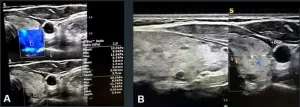(Press-News.org) Barcelona, Spain – 18 April 2023: A novel software tool set to improve the management of elderly atrial fibrillation patients with multiple conditions is being designed by the EU-funded and ESC-coordinated EHRA-PATHS consortium. The latest updates on this clinical innovation will be presented at EHRA 2023, a scientific congress of the European Society of Cardiology (ESC).1
Scientific coordinator Professor Hein Heidbuchel said: “EHRA-PATHS is developing a standardised approach to ensure that patients with atrial fibrillation receive evidenced-based therapies for the comorbidities that underlie or complicate their heart rhythm disorder.”
Atrial fibrillation is the most common heart rhythm disorder, affecting more than 40 million people worldwide.2 Patients with atrial fibrillation have an average of five co-existing conditions including high blood pressure, coronary artery disease, heart failure, obesity and chronic kidney disease.3 These comorbidities have a negative impact on survival.4 In addition, three-quarters of atrial fibrillation patients take at least five medications.5
EHRA-PATHS is a multicentre international project focused on integrated care for patients with atrial fibrillation and at least one additional chronic condition. The multidisciplinary programme is being coordinated by the ESC and the European Heart Rhythm Association (EHRA). An EHRA-PATHS survey of healthcare professionals previously reported that the lack of an integrated care model was hindering referrals to specialist services for atrial fibrillation comorbidities.6
Results of patient interviews, presented for the first time at EHRA 2023, highlighted the need for integrated care and interprofessional working to optimise the health of patients with multimorbid atrial fibrillation. The in-depth interviews included 30 atrial fibrillation patients with two or more additional conditions from Belgium, Greece, Poland, Spain and the Netherlands. The average age was 73 years and 37% were women. The most common comorbidity was high blood pressure, followed by high cholesterol, obesity, hypothyroidism and diabetes. Interviewees stressed the need for better communication between primary care and hospitals. Some had multiple appointments at different locations and were frustrated with the unintegrated care. While respondents had some knowledge about the relationship between comorbidities and atrial fibrillation and were motivated to make adjustments, they lacked formal education on how to implement and maintain lifestyle changes.
EHRA-PATHS investigators have defined 22 comorbidities that are relevant in patients with atrial fibrillation. For each, the consortium has created concise care pathways to check for or exclude whether a given comorbidity is present, to guide its further evaluation, and to ensure its effective management. The care pathways are now being integrated in a software tool that will assist healthcare personnel to evaluate atrial fibrillation patients in a systematic and comprehensive way. “This is the cornerstone of the overall aim of the project, which is to improve outcomes of patients with atrial fibrillation by systematic detection and management of underlying conditions, and by multidisciplinary referral or collaboration where needed,” said Professor Heidbuchel.
The software will be evaluated in a clinical study involving 65 hospitals in 14 European countries. To establish a baseline picture, in part one of the study, researchers will evaluate the management (assessment and treatment) of risk factors and comorbidities in approximately 1,300 patients aged 65 years and older with newly diagnosed atrial fibrillation. Part two will be a randomised controlled trial in 1,080 patients assessing whether allocation to the software tool improves management of atrial fibrillation compared with usual care.
The trial will focus on 12 comorbidities: hypertension, hyperlipidaemia, heart failure, overweight/obesity, renal insufficiency, smoking, diabetes, coronary heart disease, valvular disease, physical activity, chronic obstructive pulmonary disease/asthma and alcohol consumption. The primary endpoint is the number of risk factors and comorbidities that are identified and for which treatment is initiated during base mapping (part one) and at the end of the randomised controlled trial (part two). Secondary endpoints include atrial fibrillation symptom burden, quality of life, patient and healthcare professional satisfaction, referrals to other disciplines and cost-effectiveness.
Professor Heidbuchel said: “Our vision is that EHRA-PATHS will demonstrate through its clinical trial that a systematic approach to comorbidities, based on a software tool with interdependent care pathways, leads to better multidisciplinary management of patients with atrial fibrillation. If the project succeeds, it will have delivered a tool to the medical community to improve atrial fibrillation management, and to make it more uniform all over Europe and beyond.”
ENDS
END
Patients with atrial fibrillation have an average of five additional medical conditions
2023-04-18
ELSE PRESS RELEASES FROM THIS DATE:
ARRS Annual Meeting: vascularity, elastography in suspicious TIRADS scores differentiate malignant thyroid nodules
2023-04-18
Honolulu, HI | April 18, 2023—Findings from an award-winning Scientific Online Poster presented during the 2023 ARRS Annual Meeting on the island of Oahu determined that assessing the vascularity and elastography in suspect TIRADS categories can efficiently diagnose malignancy of thyroid nodules.
Acknowledging that sonographic TIRADS scoring remains the first method of imaging assessment for diagnosing malignant thyroid nodules, “we assessed the added value of shear-wave elastography (SWE) to classic TIRADS assessment,” said Leila Aghaghazvini, MD, from the department of radiology at Shariati Hospital and Iran’s University ...
American Roentgen Ray Society's Roentgen Fund presents 2023 Honorary Lecture, “Advanced High-Resolution CT,” in memory of W. Richard Webb
2023-04-18
Honolulu, HI | April 18, 2023—The American Roentgen Ray Society (ARRS) is pleased to announce that The Roentgen Fund® 2023 Honorary Lecture, “Advanced High-Resolution CT (HRCT),” will be dedicated to W. Richard “Rick” Webb, MD—the late University of California, San Francisco (UCSF) radiologist who transformed the practice of thoracic imaging.
Exploring multiple conditions diagnosed via HRCT, as well as the radiologist’s role on today’s multidisciplinary teams, “Advanced HRCT” will take place on Tuesday, April 18, 2023, 1:00–2:20 PM local time, during the 2023 ARRS Annual Meeting in Honolulu, HI.
A high-profile presentation ...
Update on the analysis method to estimate the greenhouse gas concentrations from GOSAT
2023-04-18
1. Background and objectives
The Greenhouse gases Observing SATellite (GOSAT) that is the joint mission of the Ministry of Environment, the National Institute for Environmental Studies (NIES), and the Japan Aerospace Exploration Agency has observed almost continuously since its launch and is currently in operation.
Thermal And Near-infrared Sensor for carbon Observation – Fourier Transform Spectrometer (TANSO-FTS) onboard GOSAT observes the shortwave infrared (SWIR) spectra(*1). The carbon dioxide (CO2) and methane (CH4) concentrations can be estimated by ...
Healthcare epidemiologists and infectious diseases experts review changing context for masking in healthcare settings
2023-04-18
The time has come and gone for universal masking in healthcare settings, according to healthcare epidemiologists and infectious diseases experts from healthcare systems throughout Boston and beyond. In a commentary published in Annals of Internal Medicine and co-authored by experts from Mass General Brigham, Beth Israel Lahey Health, Tufts Medicine, the VA Healthcare System Boston, and other healthcare systems across the country, the authors describe the changing context and conditions of the pandemic and outline why universal masking should no longer be required in healthcare settings.
“While critically important in the earlier ...
Cardiac arrest in hospital: survival a matter of resources
2023-04-18
Hospital inpatients have better prospects of surviving a cardiac arrest in large hospitals and well-resourced wards, and daytime cardiac arrests are also associated with better chances of survival, a University of Gothenburg thesis shows.
Cardiac arrest means that the heart stops pumping blood. Within seconds, unconsciousness occurs; within minutes, brain cells start dying, causing irreparable damage.
The key to enhancing the patients’ chances of survival is restoring the circulation of oxygenated blood in the body. ...
Early study - faecal transplant to help slow early-stage motor neuron disease progression
2023-04-18
A randomised clinical trial is looking at whether faecal microbiota transplantation (FMT) from healthy donors into adults with early-stage amyotrophic lateral sclerosis (ALS – one of the most common forms of motor neurone disease) can modulate the immune reaction during inflammation responses that characterise disease progression, and aims to investigate the relationship between specific gut bacteria and their action on immune system cells.
The preliminary findings by Dr Alessandra Guarnaccia from Columbus-Gemelli University Hospital IRCCS, Rome, Italy and ...
Preventing a measles outbreak: steps taken by London hospital to protect patients and staff potentially exposed to the virus
2023-04-18
The steps taken by a London hospital to prevent an outbreak of measles will be detailed at this year’s European Congress of Clinical Microbiology & Infectious Diseases (ECCMID) in Copenhagen, Denmark (15-18 April).
Measles, which is highly contagious, can cause serious and potentially life-threating illness and complications including blindness, encephalitis (swelling of the brain) and pneumonia. Pregnant women, infants and severely immunocompromised individuals are at highest risk.
Contracted when pregnant, it can cause low birth weight babies, premature birth, miscarriage or stillbirth.
It usually starts with cold-like symptoms, followed by a rash a few days later. ...
AI software at least as good as radiologists at detecting TB from chest X-rays
2023-04-18
AI software can accurately detect TB from chest X-rays, a study being presented at this year’s European Congress of Clinical Microbiology & Infectious Diseases (ECCMID) in Copenhagen, Denmark, (15-18 April), shows.
Tuberculosis (TB) is a major cause of death and disease worldwide. It causes 1.6 million deaths a year, making it is the 13th leading cause of death globally and the second biggest infectious killer, after COVID-19.
In low-resource settings, chest X-rays play an important role in the diagnosis of patients ...
Targeting nurse and patient ‘supercontactors’ in hospitals and long-term care facilities can help minimize spread of infectious diseases
2023-04-18
New research presented at this week’s European Congress of Clinical Microbiology & Infectious Diseases (Copenhagen, 15-18 April) shows how interventions focused on so called ‘supercontactors’ in hospitals and other long term care facilities (LTCF) can optimise infection control and reduce the spread of infectious diseases. The study is by Dr Quentin Leclerc and colleagues at Institut Pasteur and the Conservatoire National des Arts et Métiers (Paris, France).
Hospitals and ...
Using machine learning to find reliable and low-cost solar cells
2023-04-18
Researchers at the University of California, Davis College of Engineering are using machine learning to identify new materials for high-efficiency solar cells. Using high-throughput experiments and machine learning-based algorithms, they have found it is possible to forecast the materials’ dynamic behavior with very high accuracy, without the need to perform as many experiments.
The work is featured on the cover of the April issue of ACS Energy Letters.
Hybrid perovskites are organic-inorganic molecules that have received a lot of attention ...



